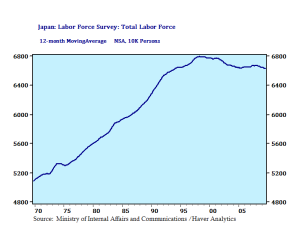The decision by China to “enhance RMB flexibility” is big news. I’m re-posting the announcement here (emphasis, yours truly’s):
In view of the recent economic situation and financial market developments at home and abroad, and the balance of payments (BOP) situation in China, the People´s Bank of China has decided to proceed further with reform of the RMB exchange rate regime and to enhance the RMB exchange rate flexibility.
Starting from July 21, 2005, China has moved into a managed floating exchange rate regime based on market supply and demand with reference to a basket of currencies. Since then, the reform of the RMB exchange rate regime has been making steady progress, producing the anticipated results and playing a positive role.
When the current round of international financial crisis was at its worst, the exchange rate of a number of sovereign currencies to the U.S. dollar depreciated by varying margins. The stability of the RMB exchange rate has played an important role in mitigating the crisis´ impact, contributing significantly to Asian and global recovery, and demonstrating China´s efforts in promoting global rebalancing.
The global economy is gradually recovering. The recovery and upturn of the Chinese economy has become more solid with the enhanced economic stability. It is desirable to proceed further with reform of the RMB exchange rate regime and increase the RMB exchange rate flexibility.
In further proceeding with reform of the RMB exchange rate regime, continued emphasis would be placed to reflecting market supply and demand with reference to a basket of currencies. The exchange rate floating bands will remain the same as previously announced in the inter-bank foreign exchange market.
China´s external trade is steadily becoming more balanced. The ratio of current account surplus to GDP, after a notable reduction in 2009, has been declining since the beginning of 2010. With the BOP account moving closer to equilibrium, the basis for large-scale appreciation of the RMB exchange rate does not exist. The People´s Bank of China will further enable market to play a fundamental role in resource allocation, promote a more balanced BOP account, maintain the RMB exchange rate basically stable at an adaptive and equilibrium level, and achieve the macroeconomic and financial stability in China.
via The People’s Bank of China–News.
I don’t know, maybe it’s just me. But if I look up “Chinese real estate bubble” and get this many results, and see articles like this, this and this in the process, I don’t see that as a sign of stability.
And with data points like this from the Straits Times…
China posted a trade surplus of US$19.53 billion (S$27.54 billion) in May, compared with a trade surplus of US$1.68 billion in April and a deficit posted in March – the first in six years.
via China trade surplus soars.
It’s hard to see how equilibrium can be used to describe well, anything. Volatility seems to be the watchword, in my view.
Then there’s this from Bloomberg Businessweek (emphasis mine, again):
June 18 (Bloomberg) — China’s finance ministry offered higher-than-expected yields at bond auctions today as a shortage of cash in the banking system damped demand for the 43.8 billion yuan ($6.4 billion) of notes it was selling to raise funds for local governments.
The 28.6 billion yuan of three-year notes sold drew bids for 1.02 times the amount offered and the 15.2 billion yuan of five-year debt was subscribed 1.06 times. The average ratio at previous treasury bond auctions this year was 1.7 times.
via China Sells 3-, 5-Year Debt at Higher-Than-Expected Yields – BusinessWeek.
A shortage of cash in the Chinese banking system? The Bloomberg piece continues:
The seven-day repurchase rate, a measure of lending costs between banks, rose eight basis points to 2.68 percent, according to a daily fixing rate published by the National Interbank Funding Center. It’s averaged 2.6 percent this month, up from 1.9 percent in May.
A 70+ basis point move in a month? That’s a lot in such a short time. There’s a funding squeeze now in China to go along with the one in Europe.
Which leads me to one conclusion: this isn’t a Yuan appreciation story, but a Yuan depreciation story. With real estate lending teetering and possible deflation in real estate assets, a Yuan appreciation will kill their internal economy and banks. All at the same time China is getting ready to list quite possibly the biggest IPO ever? This story can’t get any more tantalizing, can it?
Well, maybe. If the Yuan depreciates, it won’t be because China is deliberately setting a peg or a managed float. Because, as this piece from Bloomberg Businessweek points out:
June 21 (Bloomberg) — Chinese President Hu Jintao may have succeeded in removing the yuan’s valuation from debate at this week’s Group of 20 leaders’ summit, economists and political analysts say. How much time he’s bought depends on how flexible the currency will become.
via China’s Hu Buys Time With Yuan Announcement Before G-20 Summit – BusinessWeek.
If the enhanced flexibility means the Yuan goes lower, the Chinese would’ve pulled off a brilliant coup: a depreciating currency with little to no interference from the government.
But if it goes higher, we’ll add China to the list of countries that will be coping with deflation on top of the US, Europe, Japan and the Middle East (yes, they’re fighting it, which I’ll hopefully explain over the next few weeks). But more importantly, China’s credit risk will increase as a result of such a scenario unfolding. All while people keep talking about “rebalancing” as the needed outcome of this quagmire we’ve all found ourselves in. If deflation starts to take hold in China, that would leave India, Australia, New Zealand, Russia and Brazil as the only countries with any real economic firepower left that aren’t dealing with the deflation phenomenon.
This is starting to look like a big, elaborate domino set-up to me…












